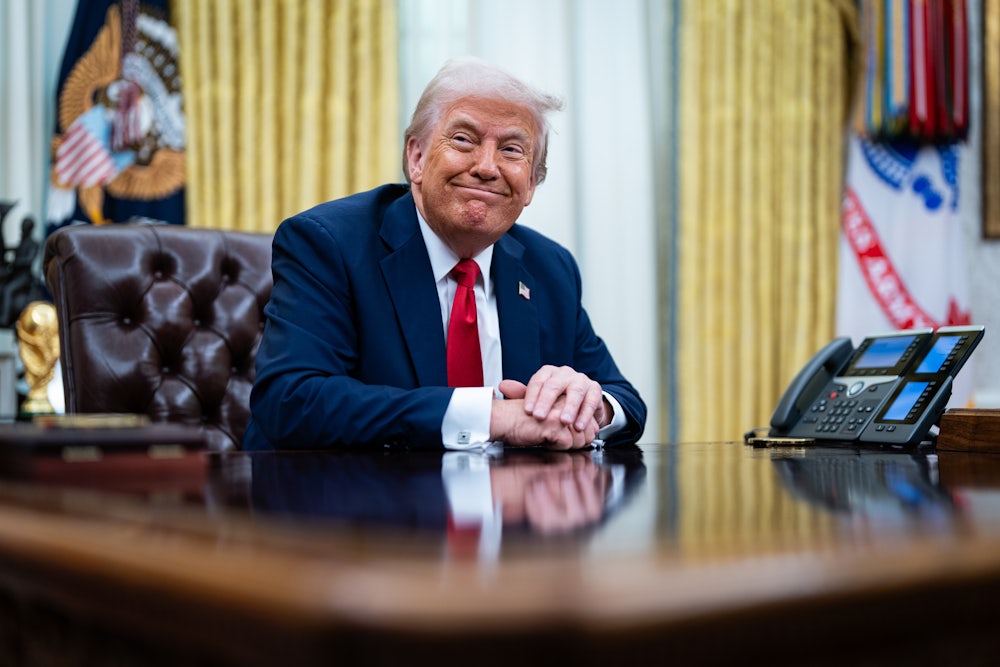Eight years ago, Don Lemon was hosting a 10 p.m. show on CNN that each night forthrightly described the antidemocratic tendencies of President Trump. Guests such as onetime Watergate reporter Carl Bernstein and former Nixon aide John Dean explained in detail how unprecedented (or Nixon-like) Trump’s actions were. Lemon himself at times delivered long diatribes castigating Trump for his racist rhetoric and demonization of journalists.
Eight years later, another talented journalist (Abby Phillip) helms the 10 p.m. hour on CNN. But the program now nearly always includes some pro-Trump guests mouthing the president’s talking points and downplaying his radicalism. In many ways, the star of News Night With Abby Phillip is conservative pundit Scott Jennings, a regular on the show whose back-and-forths with liberal guests often go viral.
CNN’s 10 p.m programming is a microcosm of a broader, monumental shift in America over the last eight years: Key institutions are accommodating and adapting to Trump, rather than challenging him. Trump is more aggressive than eight years ago, but his authoritarian tendencies were fully on display then too. The Democratic Party today, as in 2017, vacillates between aggressively confronting Trump and trying to appeal to pro-Trump swing voters. There is a strong grassroots anti-Trump movement led by groups such as Indivisible.
But what’s so different is how universities, businesses, news organizations, and other core parts of civil society are behaving now. Corporate executives who once forcefully criticized the president say little these days. Universities are reshaping their campuses to comply with Trump’s vision of higher education. Mainstream news organizations often go out of their way to legitimize policies that are authoritarian, ill-conceived, or both.
It was always going to be hard to restrain a second-term authoritarian president with an army of aides who had learned from the mistakes they made in Trump’s first term. And it’s even harder with the courts and Congress controlled by Trump-aligned Republicans. But what I have been shocked by over the last six and half months is how willing powerful American institutions are to agree with Trump—and how unwilling they are to collaborate with one another to stop him.
“The institutions did not hold,” as political organizer Mariame Kaba wrote recently. The big question is why, particularly when they did hold in many ways from 2017 to 2020. I have three explanations.
First and most obviously, the institutions have whimpered because Trump and his team are stronger and more determined than before. Once it became clear that the administration, unlike in Trump’s first term, was willing to pull federal funding from any entity that didn’t comply with his edicts, some capitulation was inevitable. Universities, even prestigious ones with large endowments, are very dependent on federal dollars. Many law firms are reliant on both government business and security clearances.
I wish these institutions had coordinated before January 20 and collectively planned for Trump having an extremely expansive (and arguably unconstitutional) view of presidential power. They were warned. But it’s fairly clear they didn’t have a strategy. So when Brown University recently announced a deal with the administration to adopt a number of Trump-backed policies on campus, that was a logical move by the school, which likely will now have hundreds of millions of dollars in federal funding restored. (Logical but perhaps still not wise. I doubt the administration will fully honor these agreements.)
Unlike from 2017 to 2020, Trump’s bites these days are sharper than his barks.
But I don’t think institutions are just accommodating Trump at gunpoint. A second explanation for why many key institutions have become more pro-Trump is that those institutions themselves have radically changed over the last eight years. The most obvious example of an institution moving in a pro-Trump direction is Twitter, which is now called X and is intentionally trying to uplift conservative voices and suppress liberal ones, after once being a haven for progressive causes such as Black Lives Matter.
Other institutions have moved right in more subtle ways since Trump’s first term. The 2022 merger of Discovery with Warner Bros put CNN under the direction of David Zaslav, who ran the merged megacompany. (Warner Bros and Discovery have recently split up.) Under Zaslav’s leadership, CNN took a number of steps to shed its liberal reputation, including firing Lemon in 2023.
Similarly, CBS’s parent company, Paramount, has been finalizing a merger with Skydance. So while CBS has not changed its name, it’s in many ways a different institution. The 2017 version of the network allowed Stephen Colbert to constantly blast Trump; CBS in 2025 canceled his show, arguing it was too expensive. (You could argue that the Colbert move fits in the self-interest category too, since the administration had to approve the merger and was more likely to do so after the companies silenced a prominent Trump critic.)
But there is a third explanation at the heart of many of the institutional accommodations with Trump, and this is the one that doesn’t get discussed as much: The institutions agree with him more than before. Trump’s early years as president resulted in a reenergized American left. The period of 2017–2025 was marked by increased labor organizing and anti-management energy, including at Big Tech companies where employees previously hadn’t been that mobilized; it was marked by the George Floyd protests and a resulting expansion of diversity and equity initiatives and anti-racism push throughout American life; a backlash against big companies and a renewed antitrust movement; intense pro-Palestinian and anti-Israel protests on campuses and in big cities; and growing acceptance of transgender Americans.
Many leaders of major companies, news organizations, colleges, and other major American institutions don’t self-identify as Democrats—and certainly aren’t progressives. They disagreed with these emerging progressive movements and sentiments, which often cast traditional institutions and their leaders as insufficiently concerned about racism, sexism, and economic inequality.
Many institutional leaders’ positions on Israel, DEI, wealth taxes, and other issues are closer to Trump’s than to the left wing of the Democratic Party. So when Trump wants to crack down on anti-Israel protests and minority-focused initiatives on campuses, I suspect many university officials, particularly the business executives on many schools’ boards, are happy with the new conservative policies and thrilled they can be blamed on having to respond to Trump instead of any desire for such changes on the part of the schools themselves. Tech executives, who steered their companies away from moderation policies that cracked down on false political content spread largely by conservatives and then appeared at Trump’s inauguration, are likely excited that President Biden’s Federal Trade Commission Chair Lina Khan is no longer in power, even if that only happened because a wannabe dictator was elected president.
When you put these three explanations together (self-interest, institutional change, institutional agreement with Trump), you can see how so many major U.S. organizations have dropped their resistance posture in Trump 2.0.
Take The Washington Post, for example. (I was one of the columnists who left the Post after owner Jeff Bezos demanded the Opinion section largely focus on “personal liberties and free markets” and installed a conservative to run the department.) Making the Post less anti-Trump may keep the administration from enacting policies that negatively affect Amazon, Blue Origin, and Bezos’s other businesses. So that’s self-interest. At the same time, Bezos was very critical of the Biden administration’s economic policies and is reportedly a devoted reader of Bari Weiss’s The Free Press. So it seems likely he agrees with some or maybe many of Trump’s policies—self-interest aside.
And the Post has in some ways changed its management structure. The paper has gone from an owner who almost never intervened in journalism decisions to one who blocked an endorsement of Kamala Harris and then revamped the Opinion section in a pro-Trump direction. Bezos owned the Post in 2017 and does now, but his leadership approach has shifted so much it’s as if the paper was sold from a liberal billionaire to a conservative one.
There is still a lot of strong journalism in the Post’s news section that is fact-based and therefore portrays Trump negatively. But the paper is less anti-Trump than from 2017 to 2020, with its opinion pages no longer including Dana Milbank, Eugene Robinson, Jennifer Rubin, and many other eloquent critics of the president.
What do pro-democracy forces do when key institutions accede to an authoritarian leader? That will be a subject of many of my future columns. But part of the puzzle will be creating and fostering alternative institutions. My hope is that readers worried about rising authoritarianism in America invest in publications that are unabashedly anti-Trump, such as many of the Substacks run by individual writers, The American Prospect, The Nation, and yes, The New Republic. Donors who want to support universities should consider giving money to Wesleyan University, whose president, Michael Roth, has been a singular voice calling out the administration’s attacks on higher education and urging a collective response. I urge people to start posting on Bluesky, even if they remain on Twitter too.
Our current institutions are failing us. And that should cause concern. But not hopelessness. Trump and the Republicans were defeated before. They can be defeated again. Our side’s path to victory must involve different strategies, though, because sadly so many of our elites and key institutions have chosen folding over fighting.






